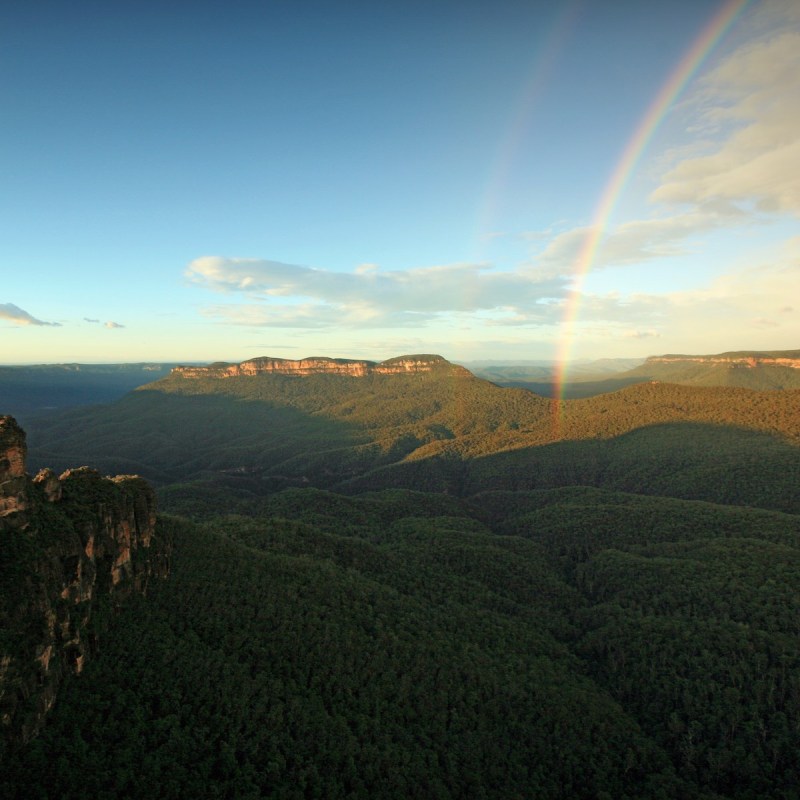
Australia’s national parks offer spectacular landscapes, from ancient forests and massive rock formations to secret glens, tinkling waterfalls, and world-famous beaches.
Videos by TravelAwaits
There are 726 national parks in Australia, more than in any other country. They cover 13,542,305 square miles, more than 4 percent of the country’s total area.
Even Australians don’t get to visit them all. I’ve taken iconic to mean famous or “widely recognized.” You may not have heard of some of the following parks, but you will recognize their drawcard attractions. Realizing overseas visitors may only have a few weeks in Australia, I’ve concentrated on iconic national parks that are also easy to slot into an itinerary.

1. Uluru-Kata Tjuta National Park, Northern Territory
Uluru-Kata Tjuta National Park is the home of the world’s largest single rock monolith (Uluru, previously known as Ayers Rock). This world-famous attraction changes color depending on the sun’s position. The Anangu traditional owners and Parks Australia jointly manage this 512-square-mile park.
Despite Uluru being 1,000 feet high (think the Eiffel Tower then go up a few notches), the bulk of Uluru is like an iceberg buried up to 1.5 miles underground. The rock is sacred to the Anangu, and most visitors also sense the deeply rooted spirituality of this place. Australia has the oldest earth crust on the planet, over 4.4 billion years old, and Uluru lies buried in its spiritual center like the beating heart of this ancient landscape. The world-famous rock is only one of the star attractions. A 40-minute drive away is Kata Tjuta, an Aboriginal word meaning many heads. These 36 gigantic monoliths are collectively bigger, taller, and wider than Uluru. Both Uluru and Kata Tjuta are protected sacred sites, and climbing them is banned. But there are over 101 different ways to experience this incredible landscape. Enjoy indigenous lead or self-guided walks. Explore Walpa Gorge. It’s like an ancient temple chiseled by nature.
The Valley of the Winds wends between Kata Tjuta’s domes. Try your hand at indigenous dot painting, ride a camel, visit rock art sites, taste indigenous foods, or helicopter or skydive over Uluru. Enjoy world-class dining under the stars overlooking the Field of Light with Uluru as your backdrop. See our picks for The 12 Best Ways to Experience Uluru for more ideas.
Accommodation options include Sails in the Desert, which emphasizes Indigenous culture, and luxury glamping at Longitude 131°. Uluru-Kata Tjuta National Park is remote but accessible. Tourists can fly directly to Ayers Rock Airport from Sydney, Melbourne, Brisbane, Darwin, Adelaide, and Alice Springs. Other cities require connecting flights.

2. Great Otway National Park, Victoria
Pentagon Motor Group crowned the Great Ocean Road the World’s Most Beautiful Road Trip Route. No wonder, with all the awe-inspiring limestone cliff top views and massive rock formations such as the 12 Apostles, which are chiseled by eons of pounding waves. But the experience is more than an open-topped car, the wind in your hair, and looking at incredible scenery as the road also slices through Great Otway National Park. Both the road and the park begin in Torquay, about an hour and a bit from Melbourne. The Great Ocean Road wends 100 miles through to Princetown, while the park also extends into the Otways hinterland. The rugged coastlines, sandy beaches, rock platforms, and windswept heathland are also part of this park.
Plan stops where you can walk through tall forests and ferny gullies, past magnificent waterfalls and tranquil lakes. Walks can be as simple as Maits Rest, a 30-minute circuit off the Great Ocean Road, or as intense as the eight-day (seven-night) Great Ocean Walk. Shuttle services are available for pick up and drop off between your parked car or accommodation. There are also shorter beach hikes. Accommodation ranges from campgrounds to luxurious properties with hot tubs. The last time I drove the Great Ocean Road, I continued to the Deep Blue Spa in Warrnambool, where hot pools replicate the tranquility of the Otways. Locals always have their favorite accommodations; mine is the scenic caravan park at Wye River. Learn more about my trip in What It’s Like For Locals Traveling In Australia Right Now.

3. Blue Mountains National Park, New South Wales
The Heritage-listed Blue Mountains National Park is tucked 50 miles behind the metropolis of Sydney. During the early days of settlement, the rugged mountains prevented Sydney’s expansion into the fertile plains beyond. There are plenty of coach tours, but independent travelers can reach this stunning area by train in less than an hour. The mountains appear blue from a distance as the eucalyptus and gum trees emit oils that combine with dust particles and water vapor, and when the sun hits, it creates an illusion of blue haze.
The most popular attraction in the Blue Mountains is the Three Sisters at Katoomba. There’s nothing quite like standing at the edge of Echo Point Lookout and seeing these towering rock formations named Meenhi, Wimlah, and Gunnedoo. Read the evocative Aboriginal legend that will stay with you forever. Some 800 steps below lies the Jamieson Valley with its 87 miles of walking trails. Descend the world’s steepest Scenic Railway, an original coal mine railway with an incline of 52° and a 1,017-foot route. Or glide over the valley on a cableway past Orphan Rock and the Three Sisters. Most visitors only uncover this tiny part of the Blue Mountains, but there’s much more to do in this 662,130-acre national park.
Hike the National Pass carved into the edge of a cliff; the trail begins at Conservation Hut and enters the Valley of the Waters, where waterfalls surround you, before continuing to the historic Grand Stairway, hand-built using picks and shovels more than a century ago. Visit the stunning Jenolan Caves, so cavernous they hold operas here. There are many historic hotels and rambling guest houses. Stay in a cave or luxury accommodation such as Emirates One&Only Wolgan Valley. Mountains attract creative people, and the Blue Mountain towns, such as Katoomba and upscale Leura, are full of writers, musicians, artists, galleries, and quaint tea rooms. Yulefest, in our winter, showcases the quaint restaurants with their log fires and comfort food.

4. Kakadu National Park, Northern Territory
Crocodile Dundee (1986) propelled Kakadu, Australia’s largest national park, into the spotlight. Kakadu’s beauty and wildlife are now legendary. The closest main town is Darwin, so grab a tour or drive yourself as the edge of Kakadu is under two hours away. I joined a Yellow Water Billabong wetlands boat tour. About one-third of Australia’s bird species are found in Kakadu, with 60 species in the wetlands, including jabiru, egrets, and magpie geese. On the banks were brumbies (wild horses) and water buffalo soaking in the floodplains. While it felt safe on the boat, there’s a morbid fascination in watching crocodiles slither down muddy embankments, then lay in wait with only their prehistoric heads and evil eyes peeking up through the pink water lilies. No trailing fingers in this water!
Elsewhere in Kakadu, wander through Aboriginal rock art sites such as Nourlangie and Ubirr — the oldest historical records of any group of people in the world. Hike one of the 30 walking trails from short strolls to challenging multi-day treks. Fly over Jim Jim Falls — a 656-foot tall waterfall — and Twin Falls, where the water rages in summer (the Top End’s wet season). Or plunge into the pools at Maguk and enjoy a back massage under the falls, your reward for walking through the monsoon rainforest. There are plenty of scenic campgrounds and even a Mercure Hotel shaped like a crocodile.

5. Whitsunday Islands National Park, Queensland
The Whitsunday Islands are the rugged remnants of coastal mountains that have remained above the water even after rising sea levels submerged the rest of the area — the result of melting ice caps some 19,000 to 6,000 years ago. The area is famous for its turquoise blue waters, dazzling white silica sands, and green islands. Many of the 74 Whitsunday islands are national parks and Robinson Crusoe-like tropical paradises for hiking and camping. The largest is Whitsunday Island, where Whitehaven Beach was ranked the Best Beach in the World by TripAdvisor readers in 2021.
At Hill Inlet Lookout, view white silica and constantly moving tides that create a white and turquoise marbling panorama that’s stunning to behold. The Ngaro Sea Trail features sea passages suitable for kayaking between South Molle Island, Whitsunday Island, and Hook Island. Here’s a map. You can rent all the equipment you’ll need. Visit Hook Island’s Nara Inlet and explore the ancient rock art of Australia’s earliest recorded Indigenous groups. Witness the awe-inspiring acrobatic displays of majestic humpback whales every year between May and September.
The campsites are only accessible by water, and once you arrive, you can hike trails ranging from under 2 miles to more demanding 2.5 to 5 miles. Other ways to visit the island are on drop-offs from either Shute Harbour or Abel Point Marina. It’s also possible to see some of these sites without camping. Stay in Shute Harbour on the mainland and take one of the many catamaran or sailing tours to the various islands. Other people stay in Reef Suites (underwater), looking into the incredible Great Barrier Reef with its marine turtles, rays, and hundreds of darting and colorful fish. Whitsunday resorts are on Daydream, Hayman, and Hamilton islands, with qualia on Hamilton ranked as the Best Luxury Resort in Australia.
Resorts are connected to the mainland via daily ferry services or helicopter, seaplane, or light aircraft. Or invest in a Hopper Pass. This enables tourists to visit a couple of resort islands and use the pools and facilities. Unless road tripping, the easiest way to reach the Whitsunday Islands is by plane. The largest inhabited island, Hamilton Island, has its own airport (Great Barrier Reef Airport), with direct flights from Brisbane, Cairns, Sydney, and Melbourne. For more information, consider this guide to the Whitsundays.
Pro Tips
There are many other iconic Australian national parks I could have mentioned. The prehistoric forests of the Daintree near Cairns and the beehive Bungle Bungles in Purnululu National Park or the thousands of limestone pillars known as the Pinnacles in Nambung National Park, both in Western Australia, are all worth your consideration. Tasmania’s pristine wilderness parks are remarkable. Victoria’s Dandenong Ranges and the Grampians are paradises for walkers. But with 726 national parks to write about, this was at least a start.
